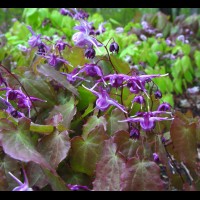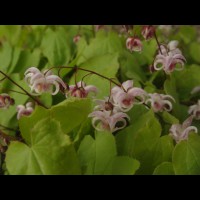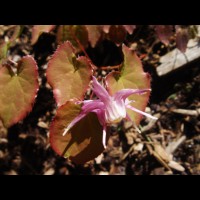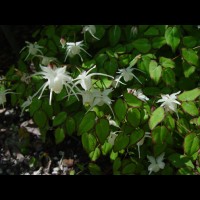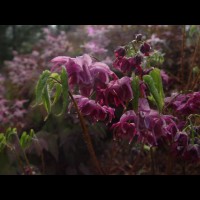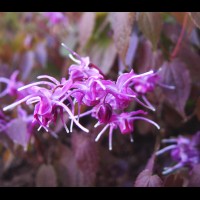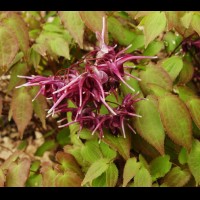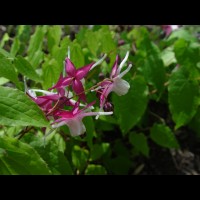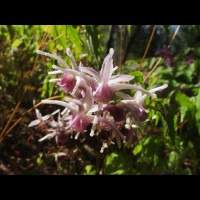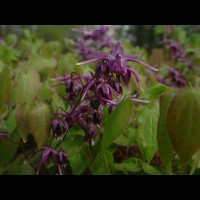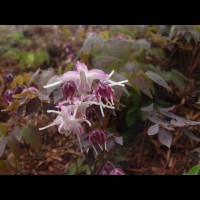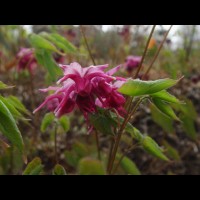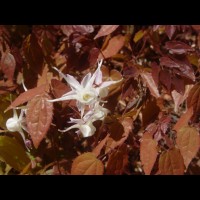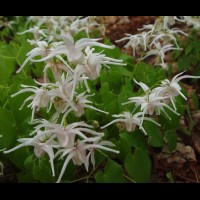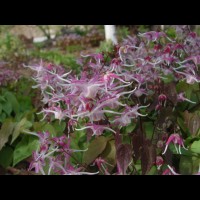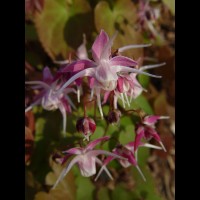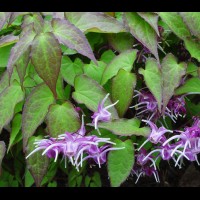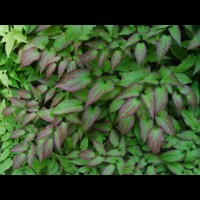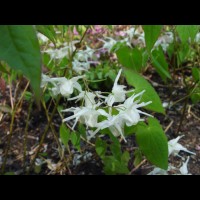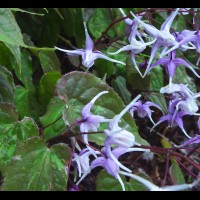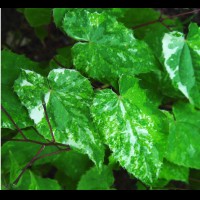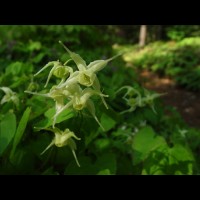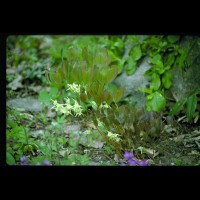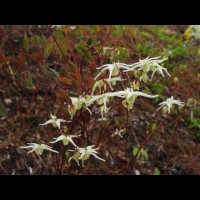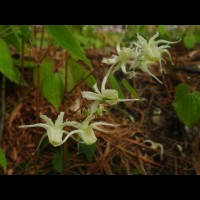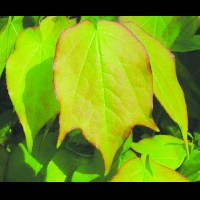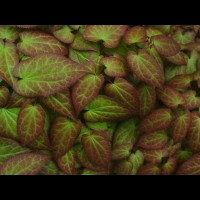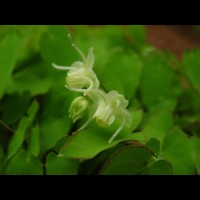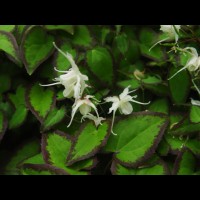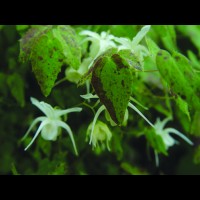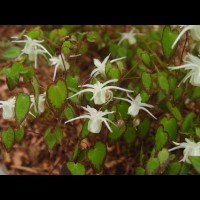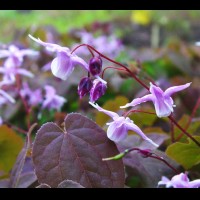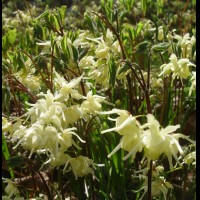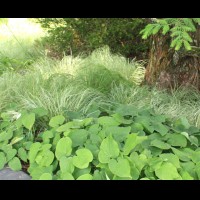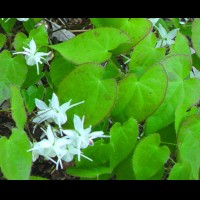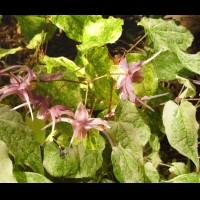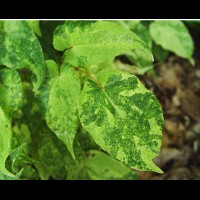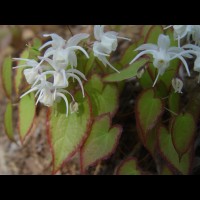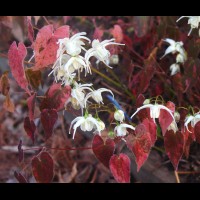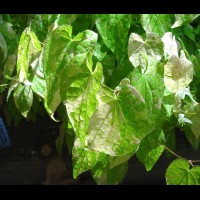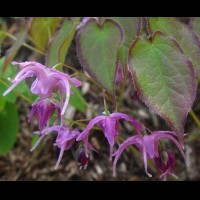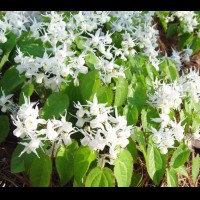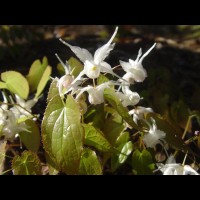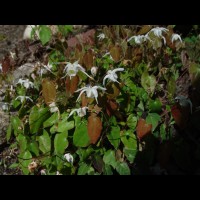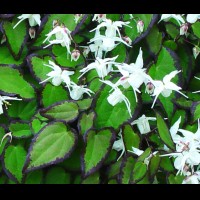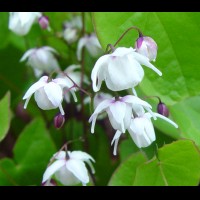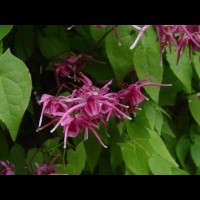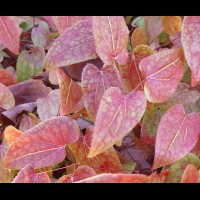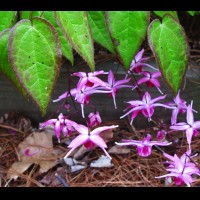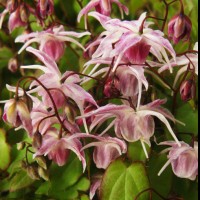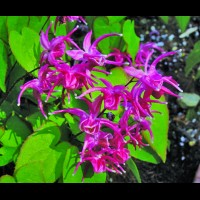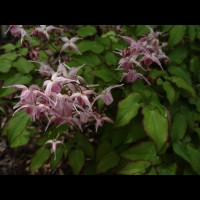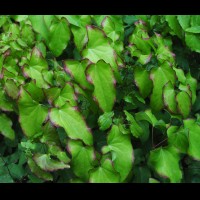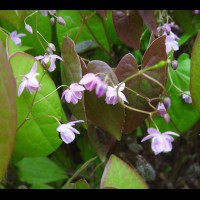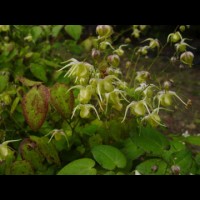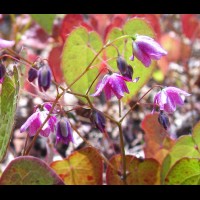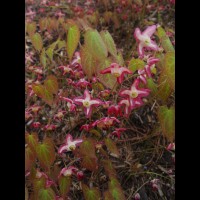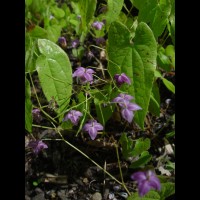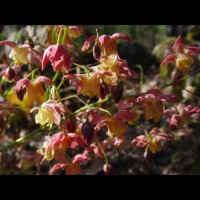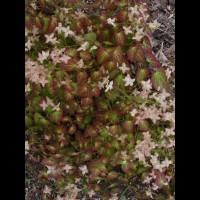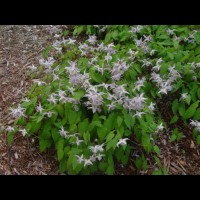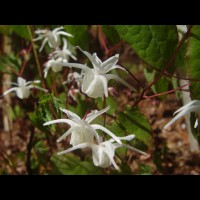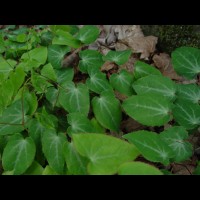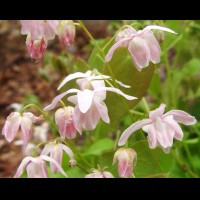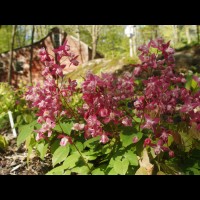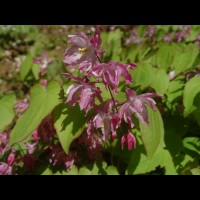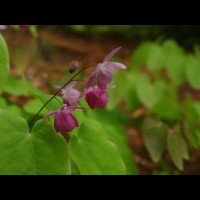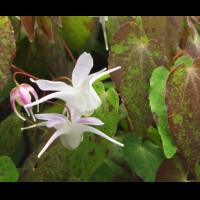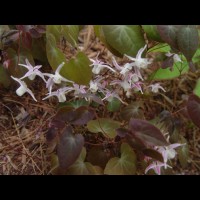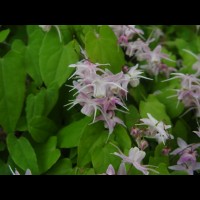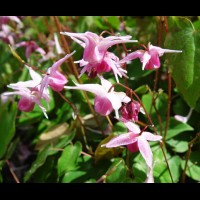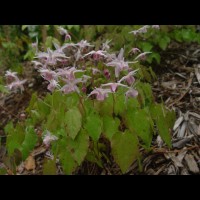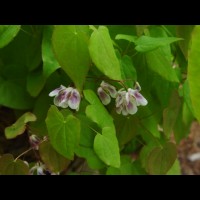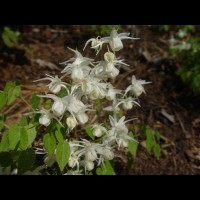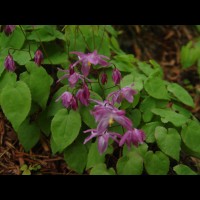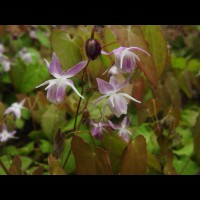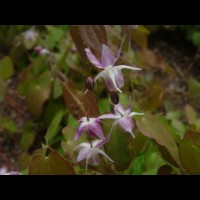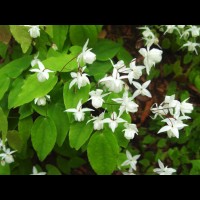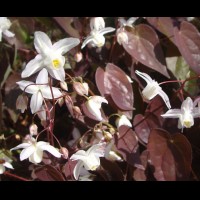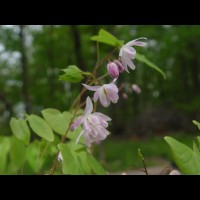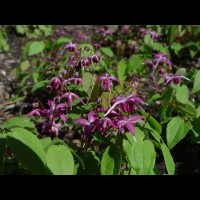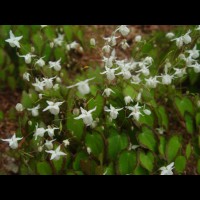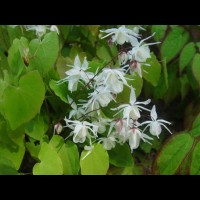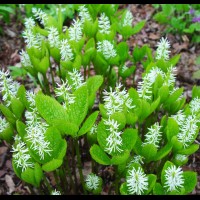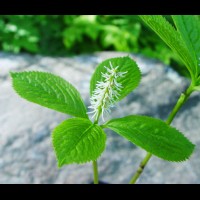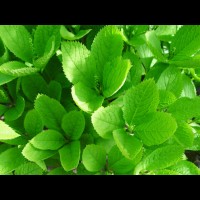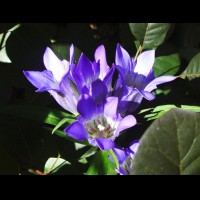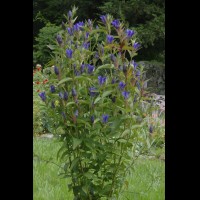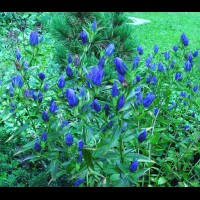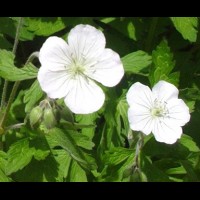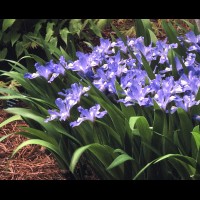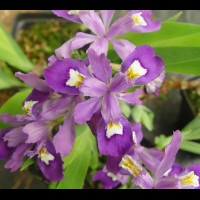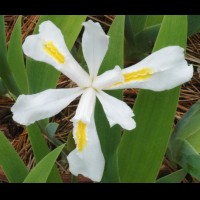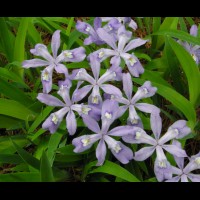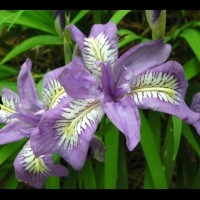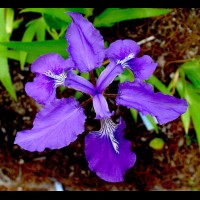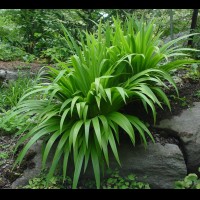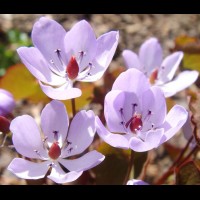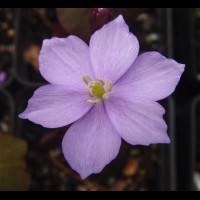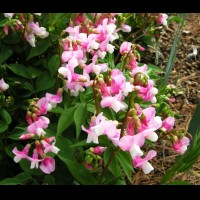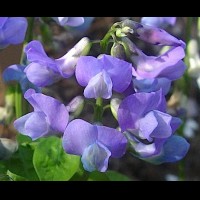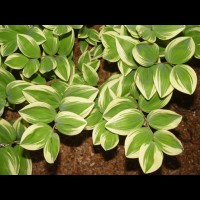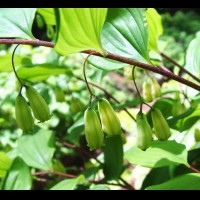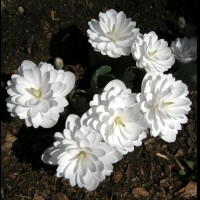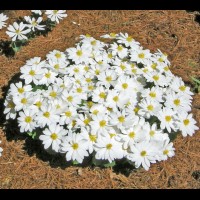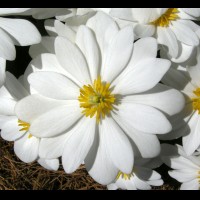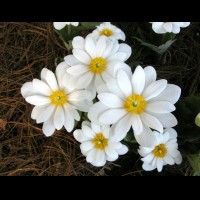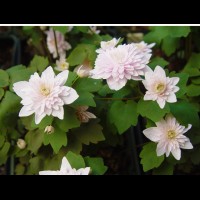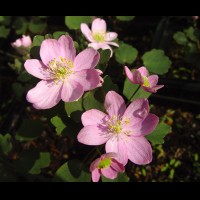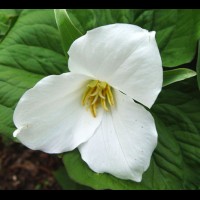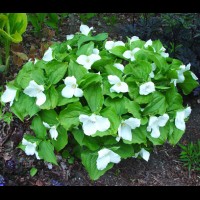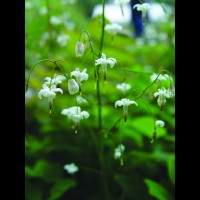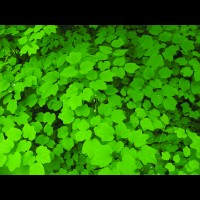Epimedium alpinum
Epimedium alpinum (Cc. 920002)
This drought tolerant spreading species from southern Europe sports very small flowers held below and among medium-sized leaflets. Inner-sepals are red behind creamy-yellow petals/spurs. 12" tall. The leaflets flaunt a complementary thin, mascara-like red edge while the plant is in bloom. Spreads 8-12" a year, forming an open groundcover. Semi-evergreen.
Epimedium alpinum 'Shrimp Girl'
E. alpinum ‘Shrimp Girl’ (Cc. 930006)
The clone ‘Shrimp Girl’ is shorter in height (6-8”) than E. alpinum with shorter rhizomes; spreading only 4-5” a year. Its dense growth habit and thick foliage make it far superior at crowding out weeds. Tiny blooms appear below the leaves and are not usually noticeable unless the plant is elevated on a hillside. A short, neat, ground-covering Epimedium with a "cool" name. Semi-evergreen.
Epimedium brevicornu
Epimedium brevicornu (Several clones/Cc. numbers)
A beautiful hardy, deciduous species native to the northern regions in China where Epimediums are not normally found. These are divisions from plants collected during Darrell’s 2001 expedition to Henan Province where no Epimediums had been previously recorded. Produces an 8 to 10” high mass of small, rather round, heart-shaped leaflets. Numerous 10” long spikes carry “clouds” of small, star-shaped white flowers, each with short, reflexed spurs with a hint of yellow in the center. New leaflets may be speckled with reddish-purple and are thin and reminiscent of parchment paper to the touch. Hardy to Zone 4 and perhaps even 3! Early and long blooming, sometime for up to a month! $22
Epimedium diphyllum Cc. 940545
Epimedium diphyllum (Cc. 940545)
Only 5 to 10" tall in bloom, produces dainty, spur-less white, bell-shaped flowers over an extended period in spring for a very delicate effect. One of several clones imported from Japan. Semi-evergreen. Not available this year.
Epimedium diphyllum "Large Leaf Form"
E. diphyllum “Large Leaf Form” (Cc. 950062)
With the largest plant habit of E. diphyllum by far, its bolder leaflets are upwards of 4” long, 1-1/2” wide. White flowers slightly larger than other clones, on stems 10-12” tall. Semi-evergreen.
Epimedium diphyllum 'Nanum'
E. diphyllum ‘Nanum’ (Cc. 950054)
A sparkling gem at only 2-4" tall at first bloom, and covered in white bell-shaped flowers. Ultimately reaches 8" high. Ideal for shady rock gardens, path edges or troughs.
Epimedium diphyllum 'Variegatum'
E. diphyllum ‘Variegatum’ (Cc. 950164)
(Synonyms: 'Shiro tiri fu', 'Shiro chiri fu')
Friends Roy Herold and the late Gerry Anderson bought this plant back from Japan for Darrell in 1995. The leaflets are variously stippled—some leaves are green with flecks of white, others white flecked green. The white variegation is enhanced with 2-3 hours of direct daily sun in our nursery. Dainty white flowers hover above leaves reminiscent of small spattered painter’s palettes. Foliage gradually turns greener through the season, but the variegation is still evident in the fall as the foliage turns to rusty red. 12" tall.
Epimedium grandiflorum
E. grandiflorum (Cc. 920009) (Synonym: E. macranthum)
The typical form of the species in the U.S., with rosy inner-sepals, and creamy-white spurs and cup. The small new spring leaflets have a brown-purple cast to them that nicely complements the flower color. 7" tall in bloom, with a second growth flush to 14".
Epimedium grandiflorum 'Album'
E. grandiflorum ‘Album’ (Cc. 950063)
A favorite of Darrell's since the first time he saw it in Harold Epstein’s garden, as it really stands out, very fresh and bright in the spring. Originally imported from Japan, it has large, pristine white flowers suspended above small, crisp apple green spring leaflets for a strikingly clean contrast. 6” tall in bloom, second flush reaches 12-14”. Not as strong a grower as many other E. grandiflorum varieties.
Epimedium grandiflorum 'Benedict's Violet'
E. grandiflorum ‘Benedict’s Violet’ (Cc. 950130)
This seedling originated in Dr. Herb Benedict’s garden in Hillsdale, MI. Large, reddish-grape flowers hover over young spring green leaflets with a rosy edge. 9” tall with no second growth flush. Very floriferous. A shorter Epimedium that quickly forms a clump.
Epimedium grandiflorum 'Bicolor Giant'
E. grandiflorum ‘Bicolor Giant’ (Cc. 970206)
Bold, cheerful and bright flowers and later the large leaves both make a nice show from a distance. The large flowers exhibit in-curved sugary pink spurs under wide, deep raspberry sepals. The flowers bloom from underneath the leaves, but are produced in such profusion, that they are showy nonetheless.
After bloom, the large new spring leaflets blush with red before turning to their summer green. Another giant red similar to ‘Red Queen’ and ‘Orion’, but with a bi-colored bloom. Acquired in from Gotemba Nursery, Japan in 1997 as a “pink grandiflorum”. 16” tall in flower. It has exhibited yellow, rusty orange and maroon fall colors here in Massachusetts. Forms a substantial clump that reads as a small shrub in the perennial border.
Epimedium grandiflorum 'Circe'
E. grandiflorum ‘Circe’ (Cc. 950244)
***2006 Cobblewood Introduction***
Beautiful large rose-red flowers accented with white spur tips have caught the eye of many a visitor to our open nursery weekends. This cultivar has much the same characteristics to recommend it as Epimedium grandiflorum ‘Yubae’ but with 2-3 times the number of bloom stems held above the foliage, and a shorter stature. Heavily flowered with a slightly darker cast to the young foliage. Medium-sized leaflets form a mound to 13”. An early bloomer hybridized by Darrel Probst.
Epimedium grandiflorum 'Cranberry Sparkle'
E. grandiflorum ‘Cranberry Sparkle’ (Cc. 950162)
***2002 Cobblewood™ Introduction***
Darrell’s friend Don Elick spent five days in April 1995 on a whirlwind dash through southern Japan searching for select forms of wild Epimediums that might prove useful in Darrell’s breeding program. This was his most incredible find with large, rich cranberry flowers held out horizontally on 6” stems. The small leaflets are flushed bronze in spring. Very, very late to emerge and one of the last grandiflorums to bloom. 10” tall.
Epimedium grandiflorum 'Dark Beauty'
E. grandiflorum ‘Dark Beauty’ (Cc. 950132)
Harold Epstein admired this plant for its velvety, deep chocolate-purple new spring foliage. It appeared as a seedling in his garden from an apparent cross between ‘Yubae’ and ‘Silver Queen’. Its large flowers have beautiful dark rose inner-sepals and white petals/spurs flushed with rose. Small leaflets. 8” in bloom with second flush to 12”. A strong grower and one of the first “Eps” to emerge and bloom each year in the nursery.
Epimedium grandiflorum 'First Kiss'
E. grandiflorum ‘First Kiss’ (Cc. 920019)
One of the smallest grandiflorums. Large flowers are produced just above the first set of leaves at only 4” tall. Dark lavender-rose flowers have white accents on the rim of the cup and the spur tips. Small spring leaflets are flushed purple. Second flush to 9”. Its short stature makes it great for troughs or the front of the shade border.
Epimedium grandiflorum 'French Braid'
E. grandiflorum ‘French Braid’ (Cc. 960042)
***2007 Cobblewood Introduction***
This eye-catching, vigorous, bold-foliaged seedling from Harold Epstein’s garden stands out from the pack with its bright, almost tropical spring leaf coloration. A psychedelic shade of orange flushes the edge of the leaflets that are dissected by luminous chartreuse veins flowing into an all green center. Large, elongated, overlapping leaflets tumble downward in a zig-zag pattern. Large creamy white flowers are borne underneath the expanding leaflets. 14” in bloom.
Epimedium grandiflorum 'Lavender Lady'
E. grandiflorum ‘Lavender Lady’ (Cc. 950094)
***2000 Cobblewood Introduction***
This beauty appeared as a seedling in Harold’s garden as a cross between E. sempervirens ‘Violet Queen’ and E. grandiflorum ‘Silver Queen’. Its red leaf color comes from the former and its numerous leaflets from the latter. It forms a mass of wide-spreading, low-growing leaves composed of medium-sized leaflets, their edges suffused with a deep red that fades into a soft green, netted center. This beautiful mass of foliage is topped by full panicles of large, lavender flowers with white spur tips. 8” tall in bloom. No second growth flush. Striking reddish-orange fall color. Early bloomer with a distinctly horizontal growth habit. Semi-evergreen.
Epimedium grandiflorum 'Lilac Seedling'
E. grandiflorum ‘Lilac Seedling’ (Cc. 960019)
Friend Teyl de Bordes of Scotland selected this outstanding seedling from a batch at Washfield Nursery. Medium-large, arrow-shaped leaflets emerge a spectacular deep reddish-purple in spring etched in bright green along the main veins. The color remains for about a month before turning green. 12-18” tall. Dense heads of large light lavender and white flowers are produced below the new leaves. Very showy.
E. grandiflorum 'Lilafee'
Epimedium grandiflorum 'Lilafee' (Cc. 910001)
A popular favorite for its large, delicate, violet-purple flowers with white spur tips held above small, purple-tinted spring leaflets. Reaches 8” tall in bloom with a second flush to 14” tall.
Epimedium grandiflorum 'Mizuhomaru'
E. grandiflorum ‘Mizuhomaru’ (Cc. 970236)
(Synonym: ‘Sakaru Moru’)
A curious Japanese cultivar with spurs that curve sharply inward towards the cup in cold temperatures. This unique flower form makes it a popular choice when seen in bloom at our on-site nursery sales. Medium-sized, pale lavender-purple flowers. Small leaflets. 8” tall in bloom; second growth flush to 12”. Leaves sometimes turn shrimp pink in the fall.
Epimedium grandiflorum 'Mt. Kitadake Red'
E. grandiflorum ‘Mt. Kitadake Red’ (Cc. 960020)
A darling little plant, beginning its bloom with leaves only 5” tall. The large, rose-red flowers are held above the foliage at 7” high. A second flush of leaflets follows on stems to 10”. Each small leaflet is tinted with bronze to dark reddish-purple in spring. This clone has exhibited pink and yellow fall color in the nursery.
Epimedium grandiflorum 'Nanum'
Epimedium grandiflorum ‘Nanum’ (Cc. 950149)
Perfect for a shady trough garden or border edge at only 3-5” in bloom. Second growth flush of foliage later reaches 10” in height. Medium-sized white flowers are in proportion to the size of the plant as are the tiny, rounded spring leaflets, each with a light purple band around their edge in spring. Particularly late to emerge in spring.
Epimedium grandiflorum 'Orion'
E. grandiflorum ‘Orion’ (Cc. 920020)
A giant “red" flowered Epimedium, probably originating from central Honshu in Japan. Grows 14 to 18” tall at bloom time, with large leaflets, and no second flush of growth. Large violet-red flowers are produced in profusion held below the large, bold leaflets. Flower color reads from a distance in the garden. Named by Dick Weaver.
Epimedium grandiflorum 'Pierre's Purple'
E. grandiflorum ‘Pierre’s Purple’ (Cc. 950124)
***1999 Cobblewood Introduction***
Named for Pierre Bennerup of Sunny Border Nurseries who originally shared it with Darrell. 7” tall in bloom, with a second growth flush to 15”. Beautiful, large, rich wine-purple flowers with white spur tips are borne against small leaflets flushed bronze in early spring. The intense spring color of the leaflets elicits many comments during our bloom season, but gradually fades as the flowers age. Leaflets turn a limey green in mid-autumn.
Epimedium grandiflorum 'Princess Susan'
E. grandiflorum ‘Princess Susan’ (Cc. 960044)
***1999 Cobblewood Introduction***
A beautiful, large-flowered selection from Harold Epstein’s garden, named after his daughter. Flowers are a crisp contrast of cherry-rose inner-sepals and pure white petals/spurs against small, bright green leaflets. Foliage grows more horizontally than that of other Epimediums. 8” in bloom with a second growth flush to 13”. A late bloomer.
Epimedium grandiflorum 'Pseudo Larchmont'
E. grandiflorum ‘Pseudo-Larchmont’ (Cc. 950115)
***1998 Cobblewood Introduction***
This unusually large, floriferous clone bears masses of creamy-lavender and purple blossoms with arching spurs that billow out from under the edges of the foliage. As a rule, it produces only 9 leaflets per leaf, instead of up to 15, giving bolder texture. The leaflets are dark green, narrow, and distinctively angular in shape. A strong grower, ‘Pseudo-Larchmont’ grows to 8” in bloom, with a second growth flush to 20+”.
Epimedium grandiflorum 'Purple Prince'
E. grandiflorum ‘Purple Prince’ (Cc. 950123)
The richest, deepest purple form of E. grandiflorum that we’ve ever seen. Visitors often remark at its exceptional beauty, even in bud. Spring leaves emerge a muted rose. 8” tall in bloom, with a second flush to 18”. Small leaflets, medium-sized flowers. An early bloomer.
Epimedium grandiflorum 'Queen Esta'
E. grandiflorum ‘Queen Esta’ (Cc. 920021)
A beautiful cultivar named by Harold Epstein after his wife, Esta. It was the first named seedling ever introduced from his garden. Notable for its large flowers with dark lavender inner-sepals and pale lavender spurs held against the chocolate-brown new spring foliage. It grows 6-8” tall in bloom, with a second flush of new dark leaves to 12”. Small leaflets. One of the earliest E. grandiflorums to bloom in spring.
Epimedium grandiflorum 'Red Queen'
E. grandiflorum ‘Red Queen’ (Cc. 950055)
Harold Epstein bought this imposing plant in Japan many years ago, and nicknamed it “Red Queen”. As far as we can determine, it was not a named cultivar. Large, vivid, rose-red flowers peek out from under huge leaflets that may grow to 6” long/4” wide. The bold fall foliage of this regal Epimedium sometimes turns shades of pink/orange. A second growth flush of red-tinted foliage reaches to 14”. A vigorous, bold-textured choice that makes a substantial clump over time.
Epimedium grandiflorum 'Shiratama'
Epimedium grandiflorum ‘Shiratama’ (Cc. 970068)
Ozzie Johnson of Marietta, GA brought back this striking cultivar from Japan. It produces masses of delicate 1” pristine white flowers with long, thin, elegant and prominently curved spidery spurs above a bun of medium-sized, bright apple-green leaflets at only 5” tall. Crisp and clean look to flowers and foliage. Second growth flush to 14”.
Epimedium grandiflorum 'Silver Queen'
E. grandiflorum ‘Silver Queen’ (Cc. 900003)
Very textural with leaves usually divided into 27 small leaflets that are mahogany-flushed in spring. The large white flowers have "silvery-lavender" highlights on the inner-sepals. 7" tall in bloom, second flush to 11". A parent of many cultivars. An early bloomer.
Epimedium grandiflorum 'Sirius'
E. grandiflorum ‘Sirius’ (Cc. 920024)
A 1990 Dick Weaver introduction, ‘Sirius’ originated as a seedling in Harold Epstein’s garden. The large and delicate palest of pink flowers float above small, distinctively light green leaflets. Often only 5” tall in bloom, with a second flush of growth to 10”. Blooms at the "tale-end" of the Epimedium season.
Epimedium grandiflorum 'Swallowtail'
E. grandiflorum ‘Swallowtail’ (Cc. 950238)
***2003 Cobblewood™ Introduction***
A flurry of slim, streamlined and graceful, medium-sized flowers are borne both above and among the numerous small leaflets edged with a hint of purple. The second growth flush has even better foliage color for an extended season of beauty. The flowers have sepals that are blue-lavender streaked in rose. Angular white spurs have a lavender streak and a slight downward tilt. 7” in bloom with a very horizontal growth habit. Second growth to 12". Unlike most grandiflorums, it tolerates alkaline soils.
Epimedium grandiflorum 'Tama No Genpei'
E. grandiflorum ‘Tama No Genpei’ (Cc. 950039)
A floriferous, showy Japanese selection with masses of large, crisp, bi-colored lavender/pink and white flowers held above the foliage. The lovely flowers paired with attractive purple-flecked new spring foliage gives the plant a very soft look in bloom. First blooms are held on 8” stems, with stems elongating to 16”. Small leaflets.
Epimedium grandiflorum 'Waterfall'
E. grandiflorum ‘Waterfall’ (Cc. 950113)
***2003 Cobblewood Introduction***
A large, lively, textural garden plant, full of movement. This appeared as a spontaneous seedling in the garden of Harold Epstein between E. grandiflorum f. flavescens ‘La Rocaille’ and E. grandiflorum ‘Yubae’. The medium-large, acutely tapered leaves stack in layers giving the appearance of flowing water. In spring, purple stippling is strongest at leaf edge, with an irregular mosaic of purple/red and green in the center, fading to green at the petiole. Large flowers gush forth on stems angled upward along the fringes of the foliage. Deep rose-purple sepals angle back from white spurs that flush amethyst as they near the narrow cup. 16” in bloom with colorful second growth to 20".
Epimedium grandiflorum 'White Queen'
E. grandiflorum ‘White Queen’ (Cc. 950168)
Common in the U.K., but quite rare in the U.S., Darrell received his original start of this cultivar from Dan Hinkley upon their first meeting in 1995. ‘White Queen’ has handsome, medium-sized, dark green arrow-shaped leaflets on stems to 14”. It produces no second growth flush. The edges of leaflets are flushed red in spring, while masses of large pure white flowers bloom just below the foliage.
Epimedium grandiflorum 'White Splash'
E. grandiflorum ‘White Splash’ (Cc. 970198)
Early spring leaflets are marked in a bright batik of olive, apple green, soft salmon-pink and white. As the foliage matures, the pink fades, leaving white irregular patches against a patchwork of many shades of green, lasting well into the season.
This plant came from Japan as “E. grandiflorum – Variegated”. We gave it a cultivar name to distinguish it from the others sold as such in Japan. Flowers are similar to those of the species, with medium-lavender inner sepals and white spurs. A smudge of lavender decorates the white cup. To 12” high.
Epimedium grandiflorum 'Yellow Princess'
E. grandiflorum ‘Yellow Princess’ (Cc. 940547)
***2000 Cobblewood Introduction***
Simply beautiful, the small leaflets of this form a low 5-1/2” mass with large, clean, light yellow flowers held aloft on stems to 10”. The spent flower stems are eventually engulfed by a second growth flush. From high elevations in Japan, it emerges late and is one of the last of E. grandi
Epimedium grandiflorum 'Yubae'
E. grandiflorum ‘Yubae’ (Cc. 920022)
(Synonyms: ‘Crimson’, 'Crimson Beauty’, 'Rose Queen’)
One of my favorites, this plant is often mislabeled as ‘Rose Queen’. It arrived in the west many decades ago, already given the name ‘Yubae’ in Japan, but with only Japanese characters to go by and no translation it was probably soon given an English cultivar name. Incidentally, this same plant suffered a third renaming in the U.K. when another plant, ‘Tama No Genpei’, was going around as ‘Rose Queen’ so it was re-named ‘Crimson Beauty’, perpetuating the confusion.
Yubae’s beautiful large rosy-red flowers have white spur tips. This bright flower color can read from a long distance in the garden. The young foliage, purple-bronze in spring, is only 8” tall at first bloom. A second flush of flowers and foliage reaches 18”. Early bloomer.
Epimedium grandiflorum f. flavescens #2
E. grandiflorum f. flavescens #2 (Cc. 940550)
Of the over 50 distinct clones of E. grandiflorum f. flavescens that Darrell brought back from Japan, this is by far the earliest to bloom with large, pale greenish-yellow flowers held below large, elliptical, bright apple green leaflets. Large, mature leaflets etched by the nearly parallel main veins make a bold, elegant garden statement. From the Kyoto Botanic Garden in Japan, it is very different from other clones circulating in the U.S. 20" tall. Clear yellow fall foliage. Spreads by 2-4" rhizomes.
Epimedium grandiflorum f. flavescens #3
Epimedium grandiflorum f. flavescens #3 (Cc. 950129)
Originally sold by Siskiyou Rare Plant Nursery under the invalid name E. macranthum ‘Aureum’. At 14”, it is shorter than most other E. grandiflorum f. flavescens clones offered here. Beautiful red-copper young leaflets unfurl over large, pale yellow flowers. After bloom, large, bold, oval-shaped leaflets expand to form an impressive mound. Clear yellow fall foliage color. Spreads by 2-4" rhizomes.
Epimedium grandiflorum f. flavescens #4
E. grandiflorum f. flavescens #4 (Cc. 960021)
Very different from other forms in commerce—almost like a straight E. grandiflorum. 20” tall, with 27 small leaflets per leaf, lightly bronze-tinted in spring. Large soft yellow flowers are held out from beneath the many small leaflets on long peduncles. Thin, wiry red stems arch out over the flowers, enhance the overall graceful textural nature of this clone.
Epimedium grandiflorum f. flavescens #5
E. grandiflorum f. flavescens #5 (Cc. 970232)
Reminiscent of E. koreanum ‘Harold Epstein’, with large soft yellow flowers and huge rounded leaflets, nearly as broad as long. However, its spreading rhizomes only grow 2-6” per year, forming a much thicker mass in the garden. Large, light yellow flowers held below the emerging foliage. 20” tall. Rusty red fall color.
Epimedium grandiflorum f . flavescens #6
Epimedium grandiflorum f. flavescens #6
Cc. 950188
Distinctive for the exaggerated extra points on each terminal leaflet. In spring, the large leaflets have a thin dark bronze edging with an overall light bronze blush. The smooth leaf surface and very delicate spring coloration creates a soft effect. Sizeable clusters of large, showy, pale yellow flowers are borne on long sprays beneath the leaves as they unfurl. 16” in bloom, to 20” tall. Spreads 2-4" per year.
Epimedium grandiflorum forma flavescens "Aomori Forms"
E. g. f. flavescens “Aomori Forms” (Several clones/Cc. #)
Prof. Stearn’s 1938 Epimedium monograph mentions “Faurie’s robust specimens from Aomori in Honshu, Japan”. Darrell explored the region in 1997. After several inquiries, their host led them to a steep hillside of densely planted Cryptomeria japonica, beneath which grew knee-high Epimediums with leaflets the size of your hand! Spring leaflets often flushed bronze-purple on 15-24” stems. Large, light yellow flowers open beneath the unfurling leaves. Rhizomes spread 2-4” a year, creating massive clumps over time.
Epimedium grandiflorum f. flavescens 'Chocolate Lace'
E. grandiflorum f. flavescens ‘Chocolate Lace’ (Cc. 980200)
***2003 Cobblewood Introduction***
Yummy, milk-chocolate tones on the emerging spring leaflets later melt into a rich burgundy tracing over a green backdrop with deep purple edges, before they mature to green. Large creamy, yellow-green flowers are held below the foli
Epimedium grandiflorum f. flavescens 'LaRocaille'
Epimedium grandiflorum f. flavescens ‘La Rocaille’ (Cc. 950040)
Originally offered in the 1970’s as E. grandiflorum f. flavescens by George Schenk of The Wild Garden, Bothel, WA. Plants established in Harold’s garden 25 years before grew into a large mass 6’ across. Its vigorous habit, long arrow-shaped leaflets and large, pale yellow flowers moved Harold to name it after his garden. Foliage is flushed a beautiful red in spring. 14” tall.
Epimedium grandiflorum var. coelestre 'Alpine Beauty'
E. grandiflorum var. coelestre ‘Alpine Beauty’ (Cc. 950058)
***2000 Cobblewood Introduction***
Extremely rare in the wild and in cultivation, this is the only Epimedium that grows at montaine heights. Beauti
Epimedium grandiflorum var. higoense 'Bandit'
E. grandiflorum var. higoense ‘Bandit’ (Cc. 950057)
Although Darrell has obtained this clone from several sources, he has traced it back to a 1981 We Du Nursery purchase from Japan. It is very different from the clone he got from them eleven years later. After many years of trialing, he named it in 2000 as it is very distinct and has the most striking, dark purple band around the edge of each small leaflet as it emerges in spring. Medium-sized, creamy-white flowers cover the plant at 6” tall, with a second flush of banded leaves to 10” as the older leaves green up. A customer favorite.
Epimedium grandiflorum var. higoense 'Confetti'
E. grandiflorum var. higoense ‘Confetti’ (Cc. 960144)
***2007 Cobblewood™ Introduction***
A marvel of texture. Each leaf is composed of up to 50 small leaflets, and most are uniquely speckled, flecked and splotched with dark purple in spring. Our leafiest clone of Epimedium by far. 7” high in bloom, bearing hordes of elegantly crafted, medium-sized white flowers. All flower parts are thin and tapered, the whole giving the effect of delicate spiders floating over the foliage.
Epimedium grandiflorum var. higoense 'Saturn'
E. grandiflorum var. higoense ‘Saturn’ (Cc. 920023)
A 1991 We Du introduction named by Dick Weaver for the maroon band that circles each tiny spring leaflet. Only 4 to 5” tall in bloom, the second growth flush may reach 8”. Medium-sized, creamy-white flowers. Foliage provides a fine-textured effect in the garden. Later to bloom than most grandiflorums.
Epimedium grandiflorum var. violaceum
E. grandiflorum var. violaceum (Cc. 890001)
Exquisite deep chocolate, small, spring leaflets form a lovely background for the bright, medium- lavender flowers. One of the very earliest Epimediums to emerge and bloom in the nursery. Makes a clump 8-10” in bloom, with a second growth flush to 12”.
Epimedium koreanum 'Harold Epstein'
Epimedium koreanum ‘Harold Epstein’ (Cc. 930004)
A very cold hardy clone with huge flowers for an Epimedium— gorgeous and butter yellow. Named in honor of Harold Epstein by plantsman Jerry Flintoff, its enormous leaflets can reach over 6” long and 4-1/2" wide. Spreads 6-12" a year. It usually takes 2-3 years to establish itself and become most impressive. The flowers emerge before the leaflets unfurl in early spring. E. koreanum is notorious for just putting up one set of leaves per node each season. If the leaf suffers damage, the rhizome will remain dormant until the following year. ‘Harold’ is a great bold-textured vigorous ground cover for large areas where it can spread unimpeded. It is especially useful in combination with early spring bulbs for sequential bloom. After bloom the expanding leaves serve as camouflage for the dying bulb foliage. 15" tall.
Epimedium sempervirens
Epimedium sempervirens Cc. 950031
Medium-sized, crisp, white flowers bloom above long tapered leaflets. One of the earliest epimediums to bloom in spring. Foliage makes an 8” mound. Spring leaflets are touched with a band of red around their edge. A bright little harbinger of spring. Semi-evergreen.
Epimedium sempervirens "Variegated #2"
An exceptional variegated form of Epimedium sempervirens. Strong grower despite the generous amount of foliage that is speckled and splotched with white. Medium lavender-rose flowers. Foliage 6 to 8" high at maturity. Keeps its variegation well into late summer. Limited quantity. Darrell obtained this clone from Japan. It will be a special conversation piece in your garden.
Epimedium sempervirens "Violet"
E. sempervirens “Violet” (Cc. 950069)
One of my absolute favorites. Grown for many years by Harold Epstein, Epimedium enthusiast, this may be a named Japanese cultivar. Medium-sized lavender flowers have spurs that curve inward back towards the cup. Flowers are held above medium-sized leaflets on stems to 9” high. Unusually long, narrow leaflets sport irregular dark flecking in the spring. Semi-evergreen.
Epimedium sempervirens 'Cherry Hearts'
Epimedium sempervirens ‘Cherry Hearts’ (Cc. 950016)
***2001 Cobblewood Introduction***
As Darrell began to sort out Epimediums in cultivation years ago, Don Elick kindly sent him this plant as “true” E. sempervirens. True it might be and while its large flowers are the usual white, with the typical evergreen leaves, the new spring foliage is anything but. Emerging a vibrant cherry red, it later turns green leaving a cherry edge before fading to summer green.
Epimedium sempervirens 'Creamsickle'
Epimedium sempervirens 'Creamsickle' (Cc. 050060)
I have been growing several variegated forms of E. sempervirens, and have finally decided that this one is different enough to offer. The new spring growth surrounds its clean, white flowers a riot of deep pink and olive green swirls of color for several days during bloom. Later the leaves green up, holding onto traces of white variegation. Leaves are more limey-green in variegation than the other E. semp. 'Variegated #1' that Darrell bought in Japan, and have offered for years.
Epimedium sempervirens 'Koji'
E. sempervirens ‘Koji’ (Cc. 930003)
An attractive Japanese cultivar with sprays of large, medium lavender flowers with white highlights that hover above a mass of medium-sized leaflets 10” tall. New spring leaflets flushed with bronze. A very early bloomer.
Epimedium sempervirens 'Mars'
Epimedium sempervirens ‘Mars’ (Cc. 920035)
A rare, rose-red form of this species, named by Dick Weaver from a plant he purchased from Japan. 6” tall in bloom with a second flush to 10” tall. Medium-sized leaflets. When grown well, ‘Mars’ produces up to 30 or more flowers per stem, forming a dense head. Very showy. Medium/large, dark rose-red flowers. Rusty red/salmon fall color.
Epimedium sempervirens 'Shadow Dancer'
E. sempervirens ‘Shadow Dancer’ (Cc. 000943)
***2010 Cobblewood Introduction***
This Japanese sempervirens selection has strikingly beautiful banded foliage with a royal purple edge in spring, surrounding a interior flushed with purple. The large, violet-lavender blossoms have uniform coloring throughout. Grows to 12” in height. Semi-evergreen.
Epimedium sempervirens 'Snowshoe Lake'
Epimedium sempervirens ‘Snowshoe Lake’ (Cc. 920033)
***2014 Cobblewood Introduction***
A white flowered very floriferous form of this extremely early bloomer. Sited in bright shade or a couple of hours of sun a day, it will produce clouds of clean white medium-sized flowers, 6” above the ground at the first thaw. Leaflets sport a delicate red line along their margins in early spring.
A cheerful and fitting tribute to my late brother George who lived on Snowshoe Lake in Alaska. 8-10” at maturity. An early bloomer.
Epimedium sempervirens 'Vega'
E. sempervirens ‘Vega’ (Cc. 950211)
Named by Dick Weaver in 1995, but Darrell doesn’t think that he ever introduced it. He said, “the foliage seems almost varnished while young. It virtually glistens and it is still very glossy” (in mid-June). Dick’s original plant was from Leola Fraim of Waltham, MA in 1984. She received it from Florence Shaw in 1968. Leaflets remain glossy all season here, on stems to 6”. Pristine white flowers.
Epimedium trifoliatobinatum
Epimedium trifoliatobinatum (Cc. 950046)
Found in only a few areas on Shikoku, Japan, it is treated as a valid species by Prof. W. T. Stearn. However, Darrell Probst thinks that it looks very much like a stabilized, true-breeding form of E. x youngianum, as the area to which it is endemic is within a region where E. grandiflorum and E. diphyllum naturally overlap. This clone is only 5” tall in bloom with a second growth flush to 9” tall. Medium-sized white flowers have spurs like E. grandiflorum but are smaller and in proportion to the overall diminutive habit of this clone. Small, rounded 1" wide, bronzed spring leaflets expand to green with maroon flecks.
Epimedium 'After Midnight'
Epimedium ‘After Midnight’ (Cc. 031430)
This cultivar was introduced by Diana Reeck of Collector’s Nursery. The spring leaflets initially open a gorgeous dark chocolate brown color which tranforms into a maroon band around the edge as the leaves expand. Multitudes of medium-sized white flowers shine bright, well above the first flush of small, elongated leaflets. 6” in bloom to 12”.
Epimedium 'Anju'
Epimedium ‘Anju’ (Cc. 050047)
A very cute Japanese cultivar, with small, white flowers that have a tapered cup and short spurs. The medium-lavender outer sepals surround inner sepals with a kiss of lavender-pink at their base. Lime-green spring leaves have a thin, dark red margin at their edges.
Epimedium 'Beni Chidori'
E. 'Beni Chidori' (Cc 050001)
An attractive Japanese variety, given the name "a thousand red-birds chirping' and that is what it truly looks like in bloom- clusters of showy reddish-purple flowers with sepals a lighter shade of the same color. The medium-sized leaflets form a mound of bright green foliage to 10 in bloom, 18-20" high in second growth. Spurs are tipped in white. A very floriferous clone.
Epimedium 'Beni Goromo'
Epimedium ‘Beni Goromo’ (Cc. 050046)
A colorful, attractive Japanese cultivar with small, medium-lavender flowers held out in clusters against bronze-maroon spring foliage. The rich flower color lightens toward the tips of the curved spurs. Antique red fall foliage color. Reaches 12”-14”.
Epimedium 'Flamingo Dancer'
E. ‘Flamingo Dancer’ (Cc. 031432)
A Japanese selection named by Diana Reeck of Collector’s Nursery. Produces clusters of two-toned bright pink flowers. A narrow, deep cherry pink cup moves into lighter pink spurs subtended by darker sepals. Bright white spur tips make for a lively color combination. Each full panicle of bright flowers arches gracefully out over the beautifully speckled spring foliage. 10” high.
Epimedium 'Koharu'
Epimedium ‘Koharu’ (Cc. 050031)
Another floriferous Japanese selection. Medium sized flowers cover this plant. Flowers have a lavender pink cup backed by a lighter pink and white sepals with pink edges and spurs that lighten toward the tips. Flowers are held on dark red pedicels. The small spring leaflets edged in a thin red line.
Epimedium 'Kuki'
Epimedium ‘Kuki’ (Cc. 050002)
Heavy clusters of flowers dripping with deeply saturated color distinguish this beautiful Japanese selection. Numerous full clusters of reddish-purple flowers bloom against a background of fresh spring-green foliage. Each curved spur is tipped in white. A thin red line scribes the edge of each medium-sized new spring leaflet.
Epimedium 'Making Waves'
Epimedium ‘Making Waves’ (Cc. 031433)
A 2003 Collector’s Nursery introduction, named for its exceptional wavy-edged leaflets with a soft, irregular maroon band in spring. Out-facing, long spurred mauve-pink flowers are accented with soft pink and held well above the foliage, on dark, nodding stems. Late blooming.
E. 'Mine No Fubuki'
E. ‘Mine-no-fubuki’ (Cc. 050035)
A delicate Japanese cultivar with chocolate-tinted new foliage, which balloons up to convex, light-green leaflets edged in bronze. Dainty, bell-shaped, spur-less flowers hang from drooping pedicels. They emerge a deep mauve and fade to a light lavender-pink. Delicate in flower with handsome, bold, semi-evergreen foliage to 14”.
Epimedium 'Sunshowers'
Epimedium ‘Sunshowers’ (Cc. 050101)
***2008 Cobblewood Introduction***
This diminutive in bloom, but fast growing cultivar was created by friend Kelly Dodson of Far Reaches Farm. Cheerful, medium-sized light yellow flowers with straight, outfacing spurs are backed by short pink sepals. Numerous, erect flower panicles are held high above the foliage to 8”. Small spring leaflets are showered with red speckles. Re-blooms with secondary flushes of flecked growth to 12-14" for added appeal. This long blooming clone literally “rains” flowers. Semi-evergreen.
Epimedium 'Tanima No Yuki'
Epimedium ‘Tanima No Yuki’ (Cc. 050040)
A charming Japanese cultivar with deep rosy-mauve, bell-shaped hanging flowers held above red stained and speckled medium-sized green leaves to 10”. Provides a riot of color in spring.
Epimedium x rubrum
Epimedium x rubrum (Cc. 920042)
Often listed as variety or cultivar of E. alpinum, it is said to be a hybrid between E. alpinum and E. grandiflorum, however the colorful spring foliage could only have come from E. sempervirens ‘Violet Queen’. This slow-spreading hybrid (rhizomes 2-4”) is an excellent groundcover, forming a thick mass of medium-sized leaflets on 16” stems. Foliage flushes cherry-red in spring. The abundantly produced medium-sized flowers have red sepals, creamy-yellow spurs. Commonly referred to as drought-tolerant, but I haven't observed that to be true.
Epimedium x sasakii 'Melody'
Epimedium x sasakii ‘Melody’ (Cc. 950230)
***2001 Cobblewood Introduction***
A hybrid between E. x setosum and E. sempervirens—violet, from Harold Epstein’s garden. Medium-sized, spiny, semi-evergreen leaves form a dense clump 7” tall. Lime-green new leaflets are attractively flecked with dark purple in spring. Numerous sprays of small light lavender flowers with tiny, sharply down-curving spurs appear above the foliage to 12”. The foliage often turns red with green veins in autumn. Offers a beautiful flower/foliage combination and is a distinctive addition to the garden.
Epimedium x versicolor 'Cupreum'
Epimedium x versicolor ‘Cupreum’ (Cc. 950143)
Thanks to Carla Lankow of Renton, WA for the original stock of this captivating plant. With the same parents as ‘Versicolor’, it is similar, but has a slightly deeper flower color and more intensely red spring foliage with green venation. Usually with more numerous, slightly smaller leaflets per leaf, each more angular and less rounded. Foliage to 9” and flowers to 12”. Rhizomes grow 4-5” inches/year. Semi-evergreen with deep orange to maroon fall color. An early bloomer, it is also very drought-tolerant.
Epimedium x youngianum 'Akebono'
E. x youngianum ‘Akebono’ (Cc. 980004)
A charming small Japanese cultivar, with ¾” delicate, but full, light rose pink/lavender flowers. Small cup is backed by long, slender, pointed sepals with a white mid-rib. New growth has a reddish-cast at leaf edge. Foliage matures to small, milky-green leaves. 5” in bloom, second flush to 8”. Very floriferous.
Epimedium x youngianum 'Azusa'
Epimedium x youngianum ‘Azusa’ (Cc. 950048)
Large, clean, bright white flowers have long spurs and red outer-sepals and are held aloft the foliage on thin wiry red pedicels. Medium-sized, deep green leaflets of good substance have a striking silver overlay along the main veins, extending out over the leaf and lasting the entire season. 7” tall in bloom, second flush to 12”. Early bloomer with a very crisp, tidy appearance.
Epimedium x youngianum 'Baby Doll Pink'
E. x youngianum ‘Baby Doll Pink’ (Cc. 950072)
***1999 Cobblewood Introduction***
Either an unlabeled Japanese cultivar or a seedling from Harold’s garden. Small, spurless flowers are dark pink in bud, opening a pale pink edged in medium pink. A truly pink-flowered Epimedium. Extended bloom above small, light green leaflets with a pink tint in spring give this plant real garden merit. Only 3” tall in first flower, it continues to produce more flowers to 9” tall.
Epimedium x youngianum 'Be My Valentine'
E. x youngianum ‘Be My Valentine’ (Cc. 950231)
***1999 Cobblewood Introduction***
Named in honor of the late Betty Valentine of Berlin, CT, at the request of the CT chapter of NARGS, in celebration of her 90th birthday in1998. Betty loved Epimediums. She grew them most of her life. Covered in bright blooms at only 5-6”, the small-medium-sized flowers have deep rose-pink inner-sepals and white petals flushed rose, with very short, white spurs. Small leaflets. Second growth flush to 14” tall. Early bloomer.
Epimedium x youngianum 'Beni Kujaku'
Epimedium x youngianum ‘Beni Kujaku’ (Cc. 960011)
A fanciful Japanese "double-flowered hybrid whose name--literally translated-- means "Red Peacock". The cup is completely open, mimicking the inner-sepals in size and shape with short protruding spurs. Each flower part has a white or pale pink interior, the perimeter suffused with dark rose pink. Medium-sized “double” flowers bloom above small, medium green leaflets. 6” tall in bloom, second growth flush to 12”.
Epimedium x youngianum 'Capella'
E. x youngianum ‘Capella’ (Cc. 920045)
Introduced by Dick Weaver and one of Darrell's personal favorites. This clone has charming dark lavender-rose flowers that are small, simple and produced in profusion above small leaflets for a long period in spring. 8" in bloom with second flush to 10" with some re-bloom.
Epimedium x youngianum 'Freckles'
Epimedium x youngianum ‘Freckles’ (Cc. 950080)
***2000 Cobblewood Introduction***
'Freckles' is a seedling that appeared in Harold Epstein’s garden among a mass of ‘Milky Way’, an obvious parent. Large grandiflorum –like flowers with white inner-sepals are flushed and veined lavender with white spurs. Introduced for its pure flower colors, but named for its lively, small spring leaflets, generously speckled in purple. 7” in bloom to 18”.
Epimedium x youngianum 'Fukurasuzume'
E. x youngianum ‘Fukurasuzume’ (Cc. 950064)
A giant among the cultivars of E. x youngianum we've grown. The unique flowers are mostly made up of a “cup”. They have magenta-streaked, white inner-sepals horizontally perched above the nearly spur-less, pendent, white petals. Flowers hang in clusters below the small leaflets, slightly edged in red. 10” in bloom, reaching 15” at maturity.
Epimedium x youngianum 'Hagoromo'
E. x youngianum ‘Hagoromo’ (Cc. 980091)
New growth is flushed purple, and matures to olive-green with a contrasting white star pattern at the veins near the leaf base. Medium-sized dainty white flowers appear among the foliage on deep-red petioles. The flowers are backed by narrow lavender/pink sepals, each edged in a crisp white line. 8” in bloom, growing to 12”.
Epimedium x youngianum 'Hanagaruma'
E. x youngianum ‘Hanagaruma’ (Cc. 970065)
Ozzie Johnson of Marietta, GA bought this tiny floriferous selection for Darrell in a Japanese nursery. From a low mass of small leaflets only 6” tall, sprout 9” stems carrying many medium-sized flowers. Its grandiflorum-like flowers cluster thickly together just above the foliage, making quite a show. A pale lavender-pink cup and slender spurs are backed by lavender-pink sepals. Second flush to 10”.
Epimedium x youngianum "Japanese Cultivar"
E. ×youngianum “Japanese Cultivar” (Cc. 960051)
A charming Japanese cultivar that Epimedium connoisseur Harold Epstein purchased during his last trip to Japan, but lost the label. Sprightly, medium-sized, rose pink flowers appear above small leaflets flushed purple. White overlays the main veins of each small leaflet all season long. 6” tall in bloom, eventually growing to 9”.
Epimedium x youngianum 'Jenny Wren'
Epimedium x youngianum ‘Jenny Wren’ (Cc. 990568)
***2003 Cobblewood Introduction***
A dainty cultivar from the garden of John Marchacos, Berlin, CT. The small, dark green spring leaflets are speckled and splotched with burgundy against a softer purple wash like the markings of a tiny wren’s egg. Light, lavender-pink, medium-sized flowers stand perky and bright against the mottled foliage. 5” in bloom, to 12”. An early bloomer.
Epimedium x youngianum 'Kozakura'
E. x youngianum ‘Kozakura’ (Cc. 950194)
Siskiyou Rare Plant Nursery bought this unusual clone in Japan as E. x sasakii and offered it in 1995. Unusual in that the inner-sepals drop as the flowers open, leaving only pendulous white petals each with a deep lavender center spot. Small, bell-shaped flowers are borne above small leaflets. 9” tall in bloom. Second flush to 14-16"
Epimedium x youngianum 'Lilliputian'
E. x youngianum ‘Liliputian’ (Cc. 950128)
Friend Judy Springer shared this Don Jacobs (Eco Gardens) introduction with Darrell. A true miniature with tiny light green leaflets delicately peppered with maroon purple flecks. Only 2” tall in first bloom with 4” flower stems. Showy medium-sized, creamy-white flowers are profuse and similar to those of E. grandiflorum in shape. Second flush to 7” produces additional speckled leaflets. Early bloomer.
Epimedium x youngianum 'Marchacos Sprite'
E. x youngianum ‘Marchacos Sprite’ (Cc. 990566)
***2003 Cobblewood Introduction***
A spontaneous hybrid from the garden of John Marchacos of Berlin, CT, this lively offering sports a profusion of medium-sized, deli
Epimedium x youngianum 'Murasaki Juji'
E. x youngianum ‘Murasaki Juji’ (Cc. 970233)
An unusual flower form giving it a "double-flowered" appearance. The petals mimic the inner-sepals in size and shape with short, white-tipped protruding spurs. Full, deep rose-lavender flowers lighten slightly at the center and edges. 7” in bloom. Forms a low, compact mound of dense medium-green foliage.
Epimedium x youngianum 'Murasaki Shikibu'
Epimedium x youngianum ‘Murasaki Shikibu’ (Cc. 970202)
Purchased in Japan in 1997 at Gotemba Nursery, located in the shadow of Mt. Fuji. An adorable plant with a first flush of flowers on short 5” stems. The second flush of leaves/flowers to 9”. Very small new leaflets tinged with purple/brown. Medium-sized flowers have dark rose-purple inner-sepals, paler petals with nearly white, short spurs.
Epimedium x youngianum 'Niveum'
Epimedium x youngianum ‘Niveum’ (Cc. 910003)
Talk about a low maintenance garden plant! The first time Darrell visited Harold Epstein, Harold pointed out several healthy clumps of ‘Niveum’ planted some 40 years previous and never, ever divided!
Crowds of small white flowers sit elbow-to-elbow above small, purple-tinted leaflets in spring. 10" in bloom eventually reaching 14". One of the more common varieties available in the American market.
Epimedium x youngianum 'Purple Heart'
E. x youngianum ‘Purple Heart’ (Cc. 950234)
***2000 Cobblewood Introduction***
A Darrell Probst hybrid from a cross between E. grandiflorum var. violaceum and E. x youngianum ‘Pink Star’. Unlike other varieties where the purple spring foliage emerges at its darkest, and then fades, these small, semi-evergreen leaflets unfurl a greenish-purple and deepen to black-pur
Epimedium x youngianum 'Roseum'
Epimedium x youngianum ‘Roseum’ (Cc. 840003)
The very first Epimedium that Darrell grew as a teenager in Pennsylvania. Produces dainty pale lavender-pink bell-shaped flowers over a long period. 9" tall in bloom with a second flush of small leaflets to 12”. One of the more commonly found varieties in the American market.
Epimedium x youngianum 'Ruby Tuesday'
Epimedium x youngianum ‘Ruby Tuesday’ (Cc. 950085)
***2001 CobblewoodIntroduction***
Small and delicate, it begins to bloom at only 5” tall. After a second and third flush of foliage and flowers, it eventually reaches 14”, making it one of the latest blooming of Epimediums. Its small spring leaflets have a purple cast. Medium-sized flowers are rich, ruby-red with lighter pale rose to white spurs.
Epimedium x youngianum 'Starlet'
E. x youngianum 'Starlet' (Cc. 031431)
Introduced by Diana Reeck of Collector's Nursery. Charming medium pink/lavender blooms float over a base of medium-sized elongated leaflets, each edge sponged with deep red in spring. Lighter pink to white highlights the backs of the sepals, the edges of the petals, and the tips of the spurs. Wiry red flower stems complement the spring color of the leaflets. A long-blooming, light and airy and very floriferous selection. 6" in bloom, with a second growth flush of colorful foliage to 11". An early bloomer.
Epimedium x youngianum 'Sudama'
E. x youngianum ‘Sudama’ (Cc. 970201)
An unusual Japanese cultivar with curious raspberry red, pendent flowers borne below the unfurling leaves. The sepals never open, leaving the flower as a dark, inflated ellipse with slightly lighter shoulders. Large spring leaves flush with a soft red edge that eventually fades to a thin line. Blooms late, on 15” stems.
Epimedium x youngianum 'Tamabotan'
Epimedium x youngianum ‘Tamabotan’ (Cc. 930011)
(Synonyms: We Du Special, Special Pink and ‘Pink Ruffles’)
Medium-sized silvery lavender flowers flushed with light lavender hover above new foliage tinted purple with a unique turquoise cast. Petals/inner-sepals similar in size and shape, give the flower a “double” appearance. Small leaflets. 8” in bloom, to 18-20”.
Epimedium x youngianum 'White Cloud'
Epimedium x youngianum ‘White Cloud’ (Cc. 950232)
***2001 Cobblewood Introduction***
‘White Cloud’ blows the roof off bud count with an astounding number of flower stems per plant. With a few hours of sun each day, it literally yields clouds of small, white flowers on 6-10” stems. Each small spring leaflet sports a pale purple perimeter band. A Darrell Probst (always searching for a higher bud count) hybrid.
Epimedium x youngianum 'Yenomoto'
E. x youngianum ‘Yenomoto’ (Cc. 880001)
The pristine white flowers of this Japanese clone are distinguished by their long, straight, down-facing inner-sepals and spurs. Each flower is held by four silvery-pink outer sepals that give a distinctly bridal feel to the plant. Long blooming with Small leaflets. 8" in bloom, growing to 12" high.
Chloranthus japonicus
Chloranthus japonicus
Native to Japan and Korea. Easy to grow shade perennial with four corrugated leaves surrounding a white, bottle brush-like inflorescence. Bold, cup-shaped foliage lends interesting texture to the shade garden. Forms a small clump over time. 12-15” high.
Gentiana scabra
Gentiana scabra
An easy to grow, robust species for sun or partial shade (more shade where summers are hot). Tolerates a wide variety of soil conditions; blooms July-October. Native to northern Asia and Japan, this variable species sports erect, leafy erect stems 8 -15” high. Violet-blue, tubular upright facing flowers with 4 pointed corolla lobes. These plants are selected seedlings.
Gentiana x 'True Blue'
Gentiana x ‘True Blue’ (Plant Patent #20433)
***2008 Cobblewood Introduction***
Forms a well-branched, upright, robust column 24-36" high, by 12-18" wide, with lance-shaped leaves and 2” tubular caerulean blue flowers from midsummer-early fall. Best in part shade to full sun (in the north).
Plant in well-drained sandy loam/loamy soils with consistent moisture. A Darrell Probst hybrid. Propagation prohibited.
Geranium maculatum 'Cobblewood Ghost'
Geranium maculatum ‘Cobblewood Ghost’
This dainty woodland native bears white 1.5” blooms for 6-7 weeks in May-early June. Native to the eastern U.S. and Canada. Grows best in part shade to full sun. If planted in some sun, the dark green palmate leaves turn brilliant scarlet in fall. 2’ high by 18” wide. Darrell found this clone (far superior to the more commonly offered ‘Hazel Gallagher’) growing wild in central Massachusetts. Will naturalize in the garden from seed.
Iris cristata 'Edgar Anderson'
Iris cristata ‘Edgar Anderson’
Large flower form with periwinkle blue falls that darken below the diffused signal ring. Wide white signals bordered in a dark blue ring. 6.5” in bloom with two 2-1/4” flowers per stem. This selection has outstanding vigor, good substance, spreads quickly. An early bloomer.
Iris cristata 'Little Jay'
Iris cristata 'Little Jay'
A beautiful blue form of Iris cristata from Iris breeders Marty Shafer and Jan Sacks of Joe Pye Weeds Garden in Carlisle, MA. The blue and white crest saturates the flower with color. 4.5" tall in bloom. Vigorous spreader.
Iris cristata 'Merle's Ruby'
Exceptional for its red-violet rather than the typical blue-violet flower color, very rare in crested iris. This clone was discovered in the wild in North Carolina by a woman named Merle. It was sold for several years by Rice Creek Nurseries, but is not common in the trade. A vigorous grower and a heavy-bloomer. Recently registered with the AIS by Joe Pye Weed’s Garden in Carlisle, MA.
Iris cristata 'Montrose White'
Iris cristata ‘Montrose White’
***2010 Joe Pye Weed's Garden Introduction***
A showy, strong-growing, clean white form, originally from Nancy Goodwin at Montrose Nursery. Its large, nearly 3” diameter flowers are unique among the “albas”. Grows to 6” tall. Spreads 2-4" per year. (Photo courtesy of Jan Sacks)
Iris cristata 'Sam's Mini'
Iris cristata ‘Sam’s Mini’
***2006 Joe Pye Weed's Garden Introduction***
Another treasure from Sam Norris, collected by Sam in Olive Hill, Kentucky. A “mini” at only 3-1/2” in height, it has similarly small flowers and compact foliage. Over several years, it forms large dense mats with many bloom stalks. The flowers have a soft appearance and are medium blue-violet with white signals, yellow and white crests with a slightly darker blue-violet halo (Photo courtesy of Jan Sacks)
Iris gracilipes
Requiring similar woodland conditions as Iris cristata, this enchanting Japanese native forms small clumps of arching grassy leaves 6-8” tall. In late May/early June numerous small, 1-1/2” wide violet-lavender flowers terminate thin, wiry stems just above the leaves. Large white signal trans-versed with violet-lavender veins. Small orange crest. Leaves eventually grow to 8” long.
Iris tectorum 'Slippery Slope'
Iris tectorum ‘Slippery Slope’
***2010 Cobblewood Introduction***
Darrell has failed endless times growing the Japanese roof iris in our climate. The flower buds die over winter, starting a rot that eventually kills the plant. He collected this much hardier clone at a high elevation in the Dabashan region of southern Shaanxi Province, China. Here they were pulled up and over the icy mountain by a coal truck in Nov. 2000, hence the cultivar name.
This clone thrives in half sun on an exposed stony ridge in my garden. Best with sharp drainage in light shade/part sun. Large 4” violet blossoms emerge in late spring from 2’ × 2’ bright green foliage fans, giving a tropical appearance to an otherwise New England perennial garden. Spreads slowly, 2-5". per year, by fleshy rhizomes to form a massive clump over time, so give it some elbow room! Needs division every 3-4 years for maximum vigor.
Jeffersonia dubia "Dark Centers"
Jeffersonia dubia “Dark Centers”
Name change to: Plagiorhegma dubia "Dark Centers", but I can't bring myself to call it that.
This plant provides a pop of welcome early spring color as soon as the ground thaws. New leaflets emerge a rusty brown color to contrast with the periwinkle blue/lavender petals. A cranberry colored ovary and dark purple/black anthers add to its charm. These plants are seedlings from plants Darrell collected in the wild in Korea.
Jeffersonia dubia "Putnam's Blue"
Name change to: Plagiorhegma dubia "Putnam's Blue", but I can't bring myself to call it that.
The Asian Twinleaf is a choice perennial that any “real” garden can’t be without, and the more, the better. It blooms very early in spring, usually starting a couple of weeks before the epimediums. Its flowers fade quickly if the suddenly weather heats up. Flowers of "Putnam's Blue" open a deep blue-lavender, and fade with age. The blossoms seemingly float above the rounded, wavy-edged, almost waterlily-like leaves.
Plants bloom at about 4-6” tall, each leaf expanding to 2-3” or so across eventually forming a dense clump 8-10” tall. This selection has the same rusty-red new growth in spring, but is deeper blue-lavender in bloom than ‘Dark Centers’ with a green ovary and longer, fatter, sculpted petals. These are seed grown as Jeffersonia defies division. It originally came from Bob Putnam’s nursery via Jim Jones.
Lathyrus vernus 'Albo-roseus'
Lathyrus vernus ‘Albo-roseus’
Another tough, long-lived perennial native to Europe for either full sun or partial shade. It tolerates many situations and is a good foliage plant throughout the season. Showy racemes of bi-colored pink and white pea-like flowers in earliest spring, on neat clumps to 18”. Leaves pinnately compound. Easy to grow and long-lived. (Photo by Jan Sacks)
Lathyrus vernus 'Katrink Hull'
Blue-flowered Perennial Sweet Pea
***2011 Cobblewood Introduction***
Selected as the best from a few “blue flowered” seedlings of the perennial sweet pea in the former garden of our late friend and accomplished rock gardener Katrink Hull. Flowers are an amazing caerulean blue mixed with shades of violet blue. Vigorous growing and free flowering. Best in bright shade or a few hours of sunlight per day. Handsome green pinnate foliage (typical of the pea family) on a 12-15" high plant in summer/fall. Blooms along with the earliest Epimediums.
Polygonatum odoratum 'Carlisle'
Polygonatum odoratum ‘Carlisle’
A brilliantly variegated Japanese Solomon Seal with much wider white margins than are typical, and a slightly shorter stature-18-20”. The stems also have a slight red tint. Spreads slowly, by 2-5" rhizomes, making an excellent, showy groundcover. Great for brightening up dark spaces in the shade garden.
Polygonatum omeiense
Polygonatum omeiense
A charming Asian Solomon’s Seal from Sichuan Province, China. This attractive, low groundcover features fat, greenish-white, capsule-shaped blossoms in pairs in mid-early June in Massachusetts. Its arching stems are speckled with purple-brown and hold the undulating leaflets, giving textural interest to the garden. 12 to 15” high. Spreading rhizomes grow 2-3” per year.
Sanguinaria canadensis 'Multiplex'
Double-flowered Bloodroot
Elegant double form of the native bloodroot. The full, white, multi-petaled flowers and glaucous foliage resembles a pool of waterlilies in the spring garden. Spreads by fleshy underground rhizomes to form large colonies over time. Best in light shade. This double-flowered form blooms for a considerably longer period than the more fleeting, fertile, single-flowered forms. (Photo by Jan Sacks, Joe Pye Weed's Garden)
Sanguinaria canadensis 'Snow Cone'
Sanguinaria canadensis 'Snow Cone'
***2016 Joe Pye Weed's Garden Introduction***
A long awaited superior form selected from Sanguinaria canadensis ‘Tennessee Form’ seedlings. Each clean, white flower has 18 to 25 petals, and is 3+ inches across. A strong grower, it quickly forms a dense, prolifically flowered clump, spreading by thick, fleshy rhizomes, 2-6" per year. Blooms for a longer time than the fleeting native form. 5-5.5” tall in bloom, to 12”. It is fertile and produces seed. This clone also seems to holds its foliage longer than the other types before going dormant in summer. A true beacon of white in the early spring garden.
Sanguinaria canadensis "Tennesee Form"
Sanguinaria canadensis “Tennessee Form”
Our native Bloodroot flowers sport a single row of eight petals, whereas this form from Tennessee has at least two rows for a total of sixteen. The flowers, some reaching 3-1/4” across, cover the foliage. The interior row of petals is slightly narrower and 1/4” shorter creating a showy semi-double flower. 5-6” tall in bloom with deeply incised leaves. To 12” Spreads by thick, fleshy rhizomes, that grow 2-4" long annually. (Photos by Jan Sacks, Joe Pye Weed's Garden)
Thalictrum (formerly Anemonella) thalictroides 'Cameo'
Thalictrum thalictroides 'Cameo' (try saying that quickly, several times in a row!)
This easy-to-grow, ephemeral spring Rue Anemone produces sterile blooms over a long period in spring. Delicate, double flowers of the palest pink top the short 5-6” plants. Typically goes dormant in early summer, so mark the space it occupies, so you don’t crowd it out with other additions to the garden in its absence. Site in well-drained soils in bright shade for best results.
Thalictrum (formerly Anemonella) thalictroides 'Pink Pearl'
A cheerful, easy to grow, and long-lived, but hard to find introduction from Mt. Cuba Center in Wilmington, DE. Bright, lavender-pink up facing flowers, 1” in diameter appear with the earliest of spring wildflowers. The 6” high, Columbine-like foliage fades into dormancy by mid-summer. Prefers a bright shade location in moist, but well-drained soils. Introduced in 2007, but rare in the trade.
Trillium grandiflorum "Trina's Wisconsin Clone"
Trillium grandiflorum “Trina’s Wisconsin Clone”
***2017 Cobblewood™ Introduction***
A native trillium that I have grown for years. I was encouraged by plantsman Mark McDonough to offer it for its full rounded flower form. This lime-loving species is easy to grow forming large, blowsy, floriferous clumps. One of the most coveted plants at my Open Nursery Days. Given to me by my gardening friend Trina Van Cura. She brought it with her when she moved from Wisconsin. Reaches 15 to 18”.
Vancouveria hexandra
Vancouveria hexandra (Several Cc.)
A west coast native, and also a later-blooming relative to Epimedium. This fine-textured, low-growing groundcover sports leaflets reminiscent of “duck’s feet” to 6” high, with flower stems to 15”. Blooms about a month later than do Epimediums, producing numerous small, pendulous white flowers, similar to those of Epimedium, but with six flower parts instead of four. Very drought tolerant and an excellent ground cover for deep shade. Spreads vigorously by thin, 6-10" underground rhizomes. Rumored not to thrive in the deep south.
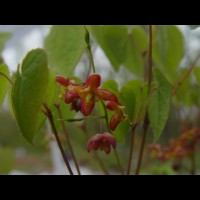
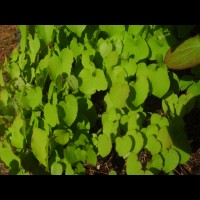
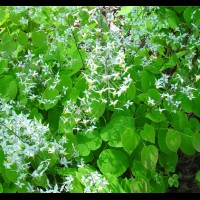
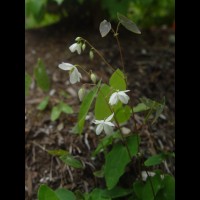
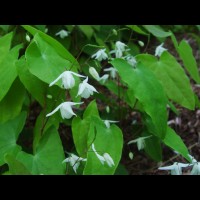
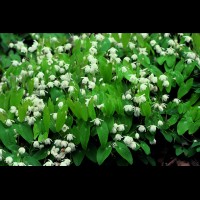
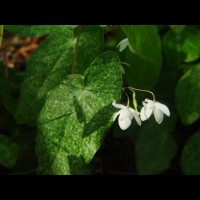
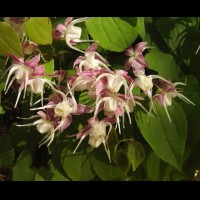
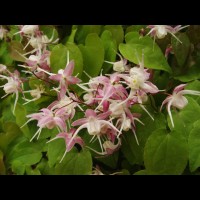
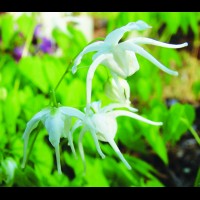
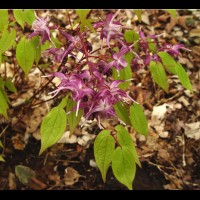
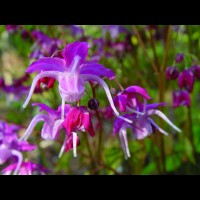

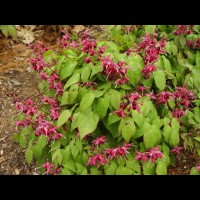
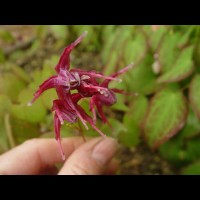
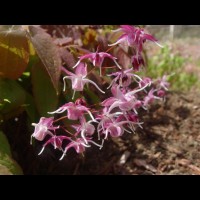
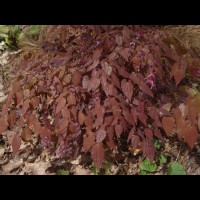
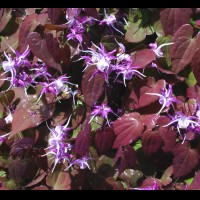
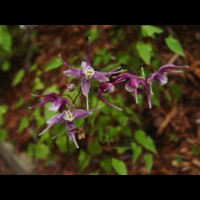
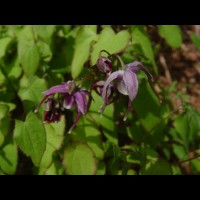

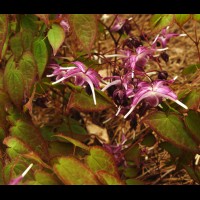
.jpg)

